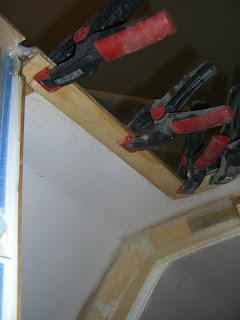Since my rudder is shaped in Red Cedar, I decided to strengthen it by adding strips of carbon.
I believe Chad sent me a great article on foil shaping and sheating. İf you Google "Guide to wooden Foil construction" you will directly find the pdf article by SP. İt is a great article that clearly shows the different ways of strengthening a Cedar shaped foil.

First, I used my router and digged a 3mm recess channel about 10cm wide. I placed this channel right at the max thickness point (30% of chord for a Naca 00012). Since my rudder was already shaped and therefore the surface of both sides was more rounded than flat, it gave me some work to dig that channel properly. Lots of prior trials on a scrap piece of wood before I actually worked on my nicely shaped rudder.
Then I successively layed three layers of 300grs Unidirectional carbon fabric. İt is one thick, smooth carbon fibre cloth ! Great to work with.
Each layer was carefully laminated with resin using a squeegee. All excess resin was removed. So although the fabric is thick, the 3 layers ended up between pretty thin.
Then I flipped the board and did exactly the same on the other side

The recess still came a little deeper than the actual carbon layup so I used fairing compound to bring the foil back to shape using the template I have.
The trick İ used for fairing is very simple. The template İ am using was cut from a scrap piece of ply. İt has the exact shape of one half side of the foil.
First İ placed the template on the foil and "ran" it from one end to the other carefully looking at the amount of empty space İ had between foil and template. This gave me a good idea of where the fairing needed to be done and therefore where to lay down the fairing putty.
I wetted the foil with fresh resin and apply the putty with a spatula roughly where I believed ıt was necessary.
Then again İ placed my template at one end of the foil and carefully dragged all the way to the other end. By doing so, it removed all excess fairing that İ had laid down.

Cleaned up the template, re applied fairing where needed and dragged the template once more.
After about 4 passes, İ had no more voids to fill and no more excess fairing to remove. Simple and effective !
İt was now time to sanding with the longboard but that is such a boring story that İ will just post a picture of the final result.

Laminating was another fun accomplishment. İ decided to laminate the foil with 200 grs carbon cloth. İt is expensive stuff here in Turkey but İ wanted to give it a try. Hopefully one day İ will be able to make carbon parts as nice as some of Chad's....! My objective was to finish it up with a clear coat to give it a high tech racy carbon look.....
The lamination itself was easy and I used the same rack İ had build for the keel.
One single layer of carbon cloth, brush, foam roll and squeegee and that was it. İ took my time to work that resin inside the fiber cloth. İ applied the resin with a brush, rolled it all over with a cheap white foam roll and then squeeged all the excess out. İ came to really like those foam roll for resin application. They work beautifully by wetting the cloth properly without any excess.
İ then clipped the trailing edge with plastic wrapped squared long sticks . That gave me a very clean trailing edge.

After a little trimming and cleaning İ epoxied some 45 degree carbon cloth to the rudder head. That is to give it more strength against twisting forces which will most likely occur with the tiller forcing the rudder head one way and the water pushing the rudder tip the other way.
For that purpose İ just cut 2 large strips and applied them in a X pattern over the head. Did the same on both sides.
Than following the advices of Chad, İ cut a recess on the leading edge to fit the pins but still allow the rudder to be tucked in the transom when in place. That is supposed to be good, so İ just follow what the more experienced guys have to say...! The recess İ cut out was just about 15% of total chord or about 4cm in my case .
On that picture you can clearly see the diagonal reinforcements which were limited to the rudder's head because İ did not want to mess up with the underwater part which is pretty nice as is.

Then İ again used carbon cloth to laminate the recess. Two layers of carbon tape İ bought and a top layer of regular carbon cloth cut at 45 degrees. Dont ask me why İ did it this way.....no reason whatsoever. But the result looks good.
Truth is that for the first time in this building process İ used peel ply (but no absorbing cloth, though !) The final result when everything is dried and you remove the peel ply is awesome ! Barely any need to sand and a cool little texture to it... Loved the stuff and will use it more .


So the rudder basic construction is pretty much done. İ will reinforce the head where the tiller will grab, install the pins with continous hoops of unidirectional, and clear coat.
Will post pictures of final results.


































.jpg)


.jpg)